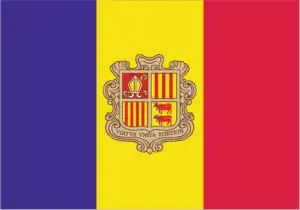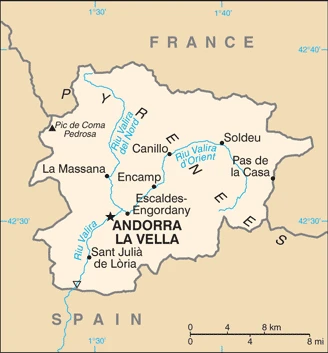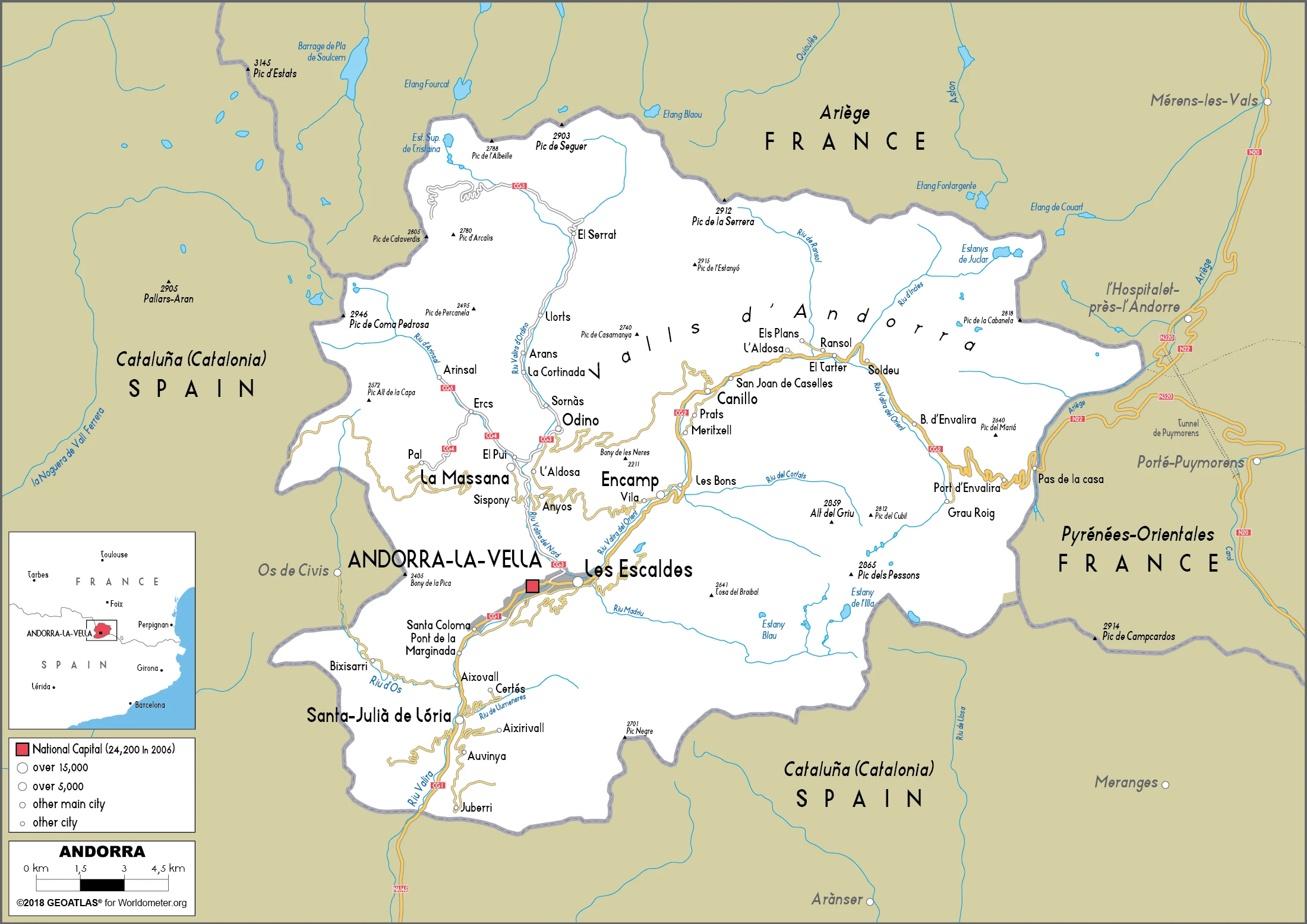Andorra Google Maps is a site/tool that offers a wide range of map views (topographic, satellite, street view) and navigation options, with little effort on your part, yet efficiently. If you need to plan a trip to a new place like Andorra, Google maps are available on desktop, mobile, or tablet. This Google maps and information page is dedicated to Andorra, Europe (47 countries), showing its location, country facts, details about its capital city Andorra la Vella, bordering countries like France Spain, and plenty of other information which may be interesting when you visit this European state.
Quick links: Google Maps Andorra, Andorra la Vella Google maps, Driving Directions Andorra, Printable Road Map.

About Andorra in a nutshell
- Andorras coprincipality status dates from the 13th century. The “princes” are the president of France and the bishop of Urgel in Spain.
- Conventional short form of the name: Andorra
- The conventional long form of the name: Principality of Andorra
- Local long form: Principat dAndorra
- Local short form: Andorra
- Former name(s): N/A
- Etymology: the origin of the country’s name is obscure; the name may derive from the Arabic ad-darra meaning the forest, a reference to its location as part of the Spanish March (defensive buffer zone) against the invading Moors in the 8th century.
- The legal system in Andorra: mixed legal system of civil and customary law with the influence of canon (religious) law.
- Climate: Cool, wet springs followed by dry, warm summers. Mountain snows linger until March.
- The national symbols are red cow (breed unspecified); national colors: blue, yellow, red.
- Internet TLD: .ad
The only river that breaks through the mountains surrounding the tiny principality on the southern slopes of the Pyrenees is the southward flowing Valira River and its two tributaries. The country has an altitude difference of more than 2,000 meters and a rugged surface, its valleys once carved by glaciers. The climate is temperate, with snowy winters and warm summers, and snow often remains on the peaks even in July. There are about 40 municipalities in the state, including some with only 12 inhabitants. The primary language spoken is Catalan, but Spanish and French are also spoken.
The capital and largest town, Andorra la Vella, was built at the confluence of two rivers at an altitude of 1,000 m above sea level – nowadays, it is mainly a trading town. The town of Encamp is home to one of Andorra’s most famous museums, the veteran car exhibition. The popular resort of Encamp is home to some of Andorra’s most popular ski slopes. Situated on the Spanish border, La Seu d’Urgell has been the seat of one of the country’s ‘co-princes’, the Bishop of Urgell, since the early 9th century. The Cathedral of Santa Maria, built in the 12th century, is Catalonia’s most beautiful Romanesque building. Andorra’s world-famous landmark is the World Heritage Site of the Madriu-Perafita-Claror Valley. The paved paths, traces of ancient settlements, terraced farming, mountain pastoralism, and iron mining are evidence of the millennia-old mountain culture of the Pyrenees. The excavation covers almost a tenth of the country’s territory.
Background
The landlocked Principality of Andorra is one of the smallest states in Europe, nestled high in the Pyrenees between the French and Spanish borders. For 715 years, from 1278 to 1993, Andorrans lived under a unique coprincipality, ruled by French and Spanish leaders (from 1607 onward, the French chief of state and the Bishop of Urgell). In 1993, this feudal system was modified with a modern constitution. The co-princes remained titular heads of state, but the government transformed into a parliamentary democracy.
Andorra has become a popular tourist destination visited by approximately 8 million people each year, drawn by the winter sports, summer climate, and duty-free shopping. Andorra has also become a wealthy international commercial center because of its mature banking sector and low taxes. As part of its effort to modernize its economy, Andorra has opened to foreign investment and engaged in other reforms, such as advancing tax initiatives to support a broader infrastructure. Although not a member of the EU, Andorra enjoys a special relationship with the bloc governed by various customs and cooperation agreements and uses the euro as its national currency.
Geography
High mountains, with six deep, glaciated valleys that drain into the Valira River as it flows into Spain.

Andorra lies high in the eastern Pyrenees, a tiny landlocked principality between France and Spain. It held its first full elections in 1993. Tourism is the primary source of income.
This state is located in Southwestern Europe, Pyrenees mountains, on the border between France and Spain, under the coordinates of 42 30 N, 1 30 E, covering an area of 468 sq km with a coastline of 0 km (landlocked country). Andorra is 2.5 times the size of Washington, DC.
Andorra has 118 km of land boundaries in total and borders with (2 nations): France 55 km, Spain 63 km.
Rugged mountains dissected by narrow valleys, with Pic de coma Pedrosa 2,946 m as the highest point of Andorra, while Riu Runer 840 m as the lowest point, causing a mean elevation at 1,996 m throughout the country. With a total of 468 sq km, Andorra has 468 sq km of land and 0 sq km water surface area.
Landlocked; straddles several vital crossroads in the PyreneesThe climate in Andorra is as follows: Temperate, snowy, cold winters and warm, dry summers.
When you visit Andorra, the natural hazards shall be considered: Avalanches.
The following major health-threatening issues shall be considered when visiting Andorra: none.
Current environmental issues affecting the Andorran people: deforestation; overgrazing of mountain meadows contributes to soil erosion; air pollution; wastewater treatment and solid waste disposal.
Google Maps Andorra
The capital and other divisions
Capital city: Andorra la Vella found under the coordinates 42 30 N, 1 31 E, applying the time zone UTC+1 (6 hours ahead of Washington, DC during Standard Time), using the following daylight saving time: +1hr begins last Sunday in March; ends last Sunday in October.
Andorra la Vella is the capital of the principality of Andorra. It was founded in 1278 by James I of Aragon as a simple parish church. Andorra la Vella is the seat of the Bishop of Urgell, making it one of the most important cathedrals in Catalonia.
Andorra became independent in 1278 (formed under the joint sovereignty of the French Count of Foix and the Spanish Bishop of Urgell), and its national holiday is Our Lady of Meritxell Day, 8 September (1278).
Administrative divisions: 7 parishes (parroquies, singular – parroquia); Andorra la Vella, Canillo, Encamp, Escaldes-Engordany, La Massana, Ordino, Sant Julia de Loria.
People and society
Immigration is strictly monitored and restricted by quota to French and Spanish nationals seeking employment in Andorra. Low taxes attract wealthy expatriates. A referendum in 1993 ended 715 years of semifeudal status, but Andorran society remains conservative.
The population in Andorra is 85,645 (July 2021 estimate), with an average of -0.1% (2021 estimate) change. That means Andorra is the No. 199 in the world’s populated rank list. With an average of 46.2 years median age (46.3 years for males and 46.3 years for women), Andorra ranks No. 6 on the globe’s median age rank list.
The people living in this country are the Andorran(s) (noun) or Andorran (adjective) and belong mainly to the following ethnic groups: Andorran 48.7%, Spanish 24.6%, Portuguese 11.6%, French 4.4%, other 10.6% (2020 estimate). Note: data represent population by nationality.
They speak Catalan (official language), French, Castilian, Portuguese languages and practice the following religions: Christian (predominantly Roman Catholic) 89.5, other 8.8%, unaffiliated 1.7% (2020 estimate).
We can conclude the following about the population in Andorra: Population is unevenly distributed and is concentrated in the seven urbanized valleys that make up the country parishes (political, administrative divisions). In Andorra, we are talking about 87.9% (2021) of the total population is living in cities, and most of them reside in the following municipalities: 23,000 Andorra La Vella (capital city) (2018).
Industry
Tourism and duty-free sales dominate the economy. Banking secrecy laws and low consumer taxes promote investment and commerce. France and Spain effectively decide economic policy. The country is dependent on imported food and raw materials.
Andorra has a developed economy and a free market, with per capita income above the European average and the level of its neighbors, Spain and France. The country has developed a sophisticated infrastructure, including a one-of-a-kind micro-fiber-optic network for the entire country. Tourism, retail sales, and finance comprise more than three-quarters of GDP. Duty-free shopping for some products and the country’s summer and winter resorts attract millions of visitors annually. Andorra uses the euro and is effectively subject to the monetary policy of the European Central Bank.
Andorra’s comparative advantage as a tax haven eroded when the borders of neighboring France and Spain opened, and the government eased bank secrecy laws under pressure from the EU and OECD. Agricultural production is limited – only about 5% of the land is arable – and most food has to be imported, making the economy vulnerable to fuel and food prices changes. The principal livestock is sheep. Manufacturing output and exports consist mainly of perfumes and cosmetic products, printing industry products, electrical machinery and equipment, clothing, tobacco products, and furniture.
Andorra is a member of the EU Customs Union and is treated as an EU member for trade in manufactured goods (no tariffs) and a non-EU member for agricultural products. To provide incentives for growth and diversification in the economy, the Andorran government began sweeping economic reforms in 2006. The Parliament approved three laws to complement the first phase of economic openness: on companies (October 2007), on business accounting (December 2007), and on foreign investment (April 2008 and June 2012). From 2011 to 2015, the Parliament also approved direct taxes in taxes on corporations, on individual incomes of residents and non-residents, and on capital gains, savings, and economic activities. These regulations aim to establish a transparent, modern, and internationally comparable regulatory framework, to attract foreign investment and businesses that offer higher value-added.
Andorra is rich in the following natural resources: Hydropower, mineral water, timber, iron ore, lead.
The main industrial sectors are typically tourism (particularly skiing), banking, timber, furniture.
The country’s export sectors are particularly strong in integrated circuits, medical supplies, essential oils, cars, tanned hides (2019), partnering with these nations: Spain 40%, France 19%, United States 11%, Mauritania 5% (2019). The export trade resulted in $78.71 million. Note: Data are in current year dollars (2015 estimate). In a global rank of the export, values resulted in Andorra’s position of 212.
Land use in Andorra: 34% (2018 estimate) forest, 26% (2018 estimate) other.
The arable land area is 1.7% (2018 estimate), and the agricultural land is 40% (2018 estimate). Land use for permanent crops 0% (2018 estimate), permanent pasture 38.3% (2018 estimate). The sum of the area of the irrigated land is 0 sq km (2012).
The main agro-industrial products of Andorra are small quantities of rye, wheat, barley, oats, vegetables, tobacco, sheep, cattle.
The country typically needs to import: cars, refined petroleum, perfumes, shaving products, liquors (2019), partnering with the following nations: Spain 71%, France 17% (2019) in a sum value of $1.257 billion (2015 estimate) $1.264 billion (2014 estimate). This sum value on the global ranking list of imports resulted in Andorra 183.
Andorra Driving Directions
In this post, you learned about Andorra, Southwestern Europe, the Pyrenees mountains, on the border between France and Spain. We published some basic information about its capital Andorra la Vella, and the Andorran nation.
Are you interested in visiting Andorra and looking for driving directions? Click here to plan your route, or see a printable road map of Andorra below for an overview of the route network.
Printable map of Andorra
Did you know about Andorra?
In 2009, Andorra became the first country to recognize civil unions between three people, and it’s also home to Europe’s youngest mayor.
After virtually visiting Andorra, you may also be interested in France and Spain, the neighboring countries.
If you liked our Google map and Andorra information page,
please share it with others or save the link https://www.drivingdirections.net in your bookmarks.

